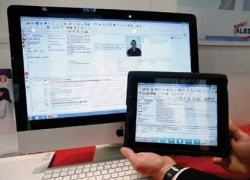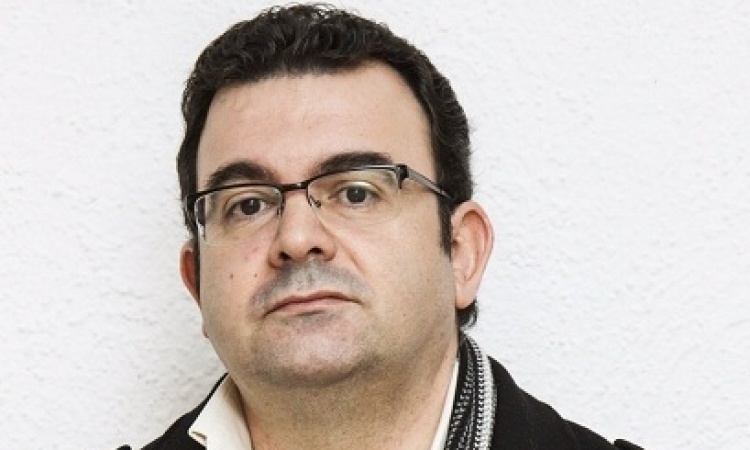Mobility IT
Medical notepads will soon be a thing of the past in doctors' offices and hospitals. More and more medical applications for smartphones and tablet PCs are coming onto the market, and many of them are introduced at Düsseldorf's MEDICA

"Stationary devices will remain in place, mobile solutions will expand the possibilities provided by existing processes." This is how Andreas Lange, chairman of the board of the German federal association of healthcare IT bvitg, sees important developments in the market for hospital information systems. It is important that physicians and nurses also benefit from them.
In the USA, the trend towards mobile applications for medical users is in full swing. Early this year the Food and Drug Administration approved a smartphone application with which physicians can access and evaluate medical images. The FDA's certification includes computed tomography (CT) and magnetic resonance imaging (MRI) as well as positron emission tomography (PET), for instance. The image data are encoded and compressed with a special software and transferred to an iPad or iPhone. The FDA approved the application for imaging evaluation such as that involved in CT, MRI and PET. However, this is not intended to entirely replace the evaluation workstation. Hence the limits of this new technology are already clear: It will never replace the workstation.
As Lange explains, these smartphone apps lend themselves to use by doctors in hospitals: "Doctors can be reached, they can examine and even document lab results". These apps should be designed to display the most essential information on these small devices so that doctors can access the information while moving between patients, wards and departments. However: "The mobile applications will never provide all the information that comprehensive hospital information systems do. They will always be limited to information for quick and simple uses."
This trend was not really started by the industry: "Users already owned smartphones and equipped them with applications with which they could look up information in medical encyclopaedias while under way, for example. This clientele expressed the wish to be able to use the smartphone to access data in their hospital information system," explains Lange. This new generation of users knows what smartphones are capable of.
Less work thanks to the app for ward rounds
The industry appears to have responded quickly. Tieto has already designed medical and nursing apps in collaboration with the Miners' Association and the Miners' Hospital in Bottrop. One application example is mobile ward rounds. Up to now, they were frequently interrupted because doctors had to approve the prescriptions made by nurses and, in order to do this, had to log in separately. These steps can be eliminated if each user has their own inexpensive device which is always up-to-date and even allows secure access from outside the hospital via a cellular phone connection. The medical and nursing app will give users of iMedOne access to the most important patient data such as lab results, findings, diagnoses, etc. Tieto not only offers these options for the iPhone but also for the iPad. Vital signs can be recorded, free texts entered, lab and radiology requests can be confirmed and approved.
All lab results and X-rays – anytime anywhere
"When I, as a physician, arrive at my ward at seven in the morning: What information do I need?" This question, for example, was one of the considerations in the development of the Checkpad MED, which Deutsche Telekom AG and Lohmann & Birkner Health Care Consulting GmbH have brought onto the market. They, too, promise to make the day-to-day work of doctors easier via the iPad. The important thing is to have uninterrupted data accessibility.
Moreover, data can be accessed in online or offline mode. For instance, a doctor can quickly check lab results in the intensive care ward to see if a surgery patient has had any bleeding. The system is designed like a medical file. The patient data from the particular ward / department is uploaded to the iPad assigned to the doctor. The data are stored on the device so that, in principle, the doctor is able to work without cellular reception. "Checkpad MED even works in the elevator. It also works in the X-ray area, and it works between two hospital buildings," assures Dr. Rüdiger Lohmann, CEO of Lohmann & Birkner Health Care Consulting GmbH. So double entries are still possible if a device is not updated quickly enough. Entries do not replace each other in these cases but, similar to Twitter, are displayed on a list when next updated. Hence double documentation remains transparent.
Standards for accounting and lab results are quite well-established and are, therefore, quite easily accessed by the mobile services. On the other hand, radiology, for instance, remains fairly complex because the data format has to be adapted to the respective hospital, says Dr. Lohmann. The adaptation of digital medical files is also a challenge. Hospitals today may have two different systems, one for the hospital information system and one for the findings system. And even if SAP, for example, is used for both, the fields in which diagnostic data is stored may have different names. Therefore, the software must be tailored to the needs of the individual hospitals.
iPad 2 provides new documentation options
Lohmann divides the development of the Checkpad MED into stages: The first stage is the introduction of the digital medical file. The second stage allows data generation on the iPad. Who saw which images becomes visible. The third stage allows task assignment directly at the patient's bedside. Comments can be attached to the findings. By the time MEDICA 2011 takes place in November, the request for findings will have been upgraded to match the expanded technical options of the iPad 2. This will allow wounds to be photographed with the iPad 2 and automatically filed in the electronic case file. The Checkpad MED is currently undergoing day-to-day capabilities testing in hospitals and additional developments are being added. "It is still too early for trial evaluations, but already the doctors seem to be enthusiastic about Checkpad MED," says Lohmann.
Siemens, too, plans to give doctors access to patient data anytime anywhere via Syngo.via, for instance with a laptop or smartphone. syngo.via WebReport and syngo.via WebViewer are already on the shelves. syngo.via WebReport provides secure access to reports and images inside and outside the hospital. syngo.via WebViewer displays images with the use of a web browser.
Andreas Lange's prediction for the German federal association of healthcare bvitg: "Last year saw the introduction of numerous apps for smartphones. I expect that this year more apps for tablet computers will be introduced at MEDICA. The possibilities are endless. Tablet computers are of particular interest in nursing.” Developments will remain fascinating up to and well after MEDICA 2011 (16 - 19 November).
Within the context of the trend theme Mobility IT, visitors to MEDICA 2011 will also find a side-trip to CTIA - The Wireless Association (Hall 15) of interest. It, too, will focus on new mobile products, applications and network management solutions specifically for the healthcare market.
17.11.2011











